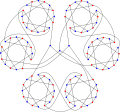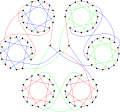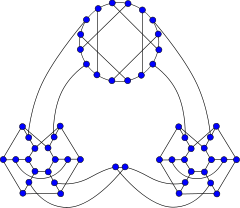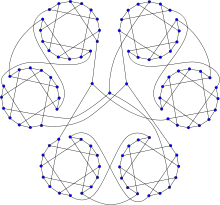Horton graph
| Horton graph | |
|---|---|
|
The Horton graph | |
| Named after | Joseph Horton |
| Vertices | 96 |
| Edges | 144 |
| Radius | 10 |
| Diameter | 10 |
| Girth | 6 |
| Automorphisms |
96 (Z/2Z×Z/2Z×S4) |
| Chromatic number | 2 |
| Chromatic index | 3 |
| Properties |
Cubic Bipartite |
In the mathematical field of graph theory, the Horton graph or Horton 96-graph is a 3-regular graph with 96 vertices and 144 edges discovered by Joseph Horton.[1] Published by Bondy and Murty in 1976, it provides a counterexample to the Tutte conjecture that every cubic 3-connected bipartite graph is Hamiltonian.[2][3]
After the Horton graph, a number of smaller counterexamples to the Tutte conjecture were found. Among them are a 92 vertex graph by Horton published in 1982, a 78 vertex graph by Owens published in 1983, and the two Ellingham-Horton graphs (54 and 78 vertices).[4][5]
The first Ellingham-Horton graph was published by Ellingham in 1981 and was of order 78.[6] At that time, it was the smallest know counterexample to the Tutte conjecture. The second one was published by Ellingham and Horton in 1983 and was of order 54.[7] No smaller non-hamiltonian cubic 3-connected bipartite graph is currently known.
As a non-hamiltonian cubic graph with many long cycles, the Horton graph provides good benchmark for programs that search for Hamiltonian cycles.[8]
The Horton graph has chromatic number 2, chromatic index 3, radius 10, diameter 10 and girth 6. It is also a 3-edge-connected graph.
Algebraic properties
The automorphism group of the Horton graph is of order 96 and is isomorphic to Z/2Z×Z/2Z×S4, the direct product of the Klein four-group and the symmetric group S4.
The characteristic polynomial of the Horton graph is :


 .
.
Gallery
-

The chromatic number of the Horton graph is 2.
-

The chromatic index of the Horton graph is 3.
-

The Ellingham-Horton 54-graph, a smaller counterexample to the Tutte conjecture.
References
- ↑ Weisstein, Eric W., "Horton graph", MathWorld.
- ↑ Tutte, W. T. "On the 2-Factors of Bicubic Graphs." Disc. Math. 1, 203-208, 1971/72.
- ↑ Bondy, J. A. and Murty, U. S. R. Graph Theory with Applications. New York: North Holland, p. 240, 1976.
- ↑ Horton, J. D. "On Two-Factors of Bipartite Regular Graphs." Disc. Math. 41, 35-41, 1982.
- ↑ Owens, P. J. "Bipartite Cubic Graphs and a Shortness Exponent." Disc. Math. 44, 327-330, 1983.
- ↑ Ellingham, M. N. "Non-Hamiltonian 3-Connected Cubic Partite Graphs."Research Report No. 28, Dept. of Math., Univ. Melbourne, Melbourne, 1981.
- ↑ Ellingham, M. N. and Horton, J. D. "Non-Hamiltonian 3-Connected Cubic Bipartite Graphs." J. Combin. Th. Ser. B 34, 350-353, 1983.
- ↑ V. Ejov, N. Pugacheva, S. Rossomakhine, P. Zograf "An effective algorithm for the enumeration of edge colorings and Hamiltonian cycles in cubic graphs" arXiv:math/0610779v1.
